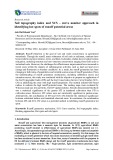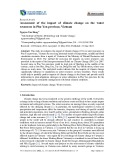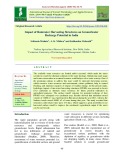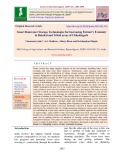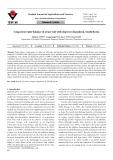
Potential runoff
-
Runoff reduction is the goal of soil and water conservation in agricultural watersheds. Through the runoff, many substances of soil such as sediment, nutrients have been eroded to end up in streams, rivers, and lakes. In decades, studies have revealed various mitigation, including structure and non–structure conservation ranging from field scale to watershed scale.
 14p
14p  viironman
viironman
 02-06-2023
02-06-2023
 5
5
 3
3
 Download
Download
-
This study investigates the impact of climate change (CC) on water resources in Phu Yen province, Vietnam by assessing historical trends of temperature, rainfall and flood simulation scenarios from a report of Vietnam of the Ministry of Natural Resources and Environment in 2020. The method for assessing the impacts on water resources was provided in the report of the Intergovernmental Panel on Climate Change (IPCC) in 2007.
 14p
14p  viironman
viironman
 02-06-2023
02-06-2023
 10
10
 3
3
 Download
Download
-
Modeling approach has considered as an effective alternative method for environmental risk assessment in recent decades. This work aimed to assess the pesticide fate and transport from rice paddy which has higher potential of pesticide runoff compared to upland fields as reported in previous studies. The study area was the Sakura River watershed, Ibaraki Prefecture, Japan.
 9p
9p  viginnirometty
viginnirometty
 04-05-2022
04-05-2022
 15
15
 2
2
 Download
Download
-
Know the runoff volume for a watershed as runoff is the most important hydrological component for a design of any hydrologic structure and especially in the area of water scarcity (Ibrahim Kaleel et al., 2018). In carrying out water availability studies, it is always appropriate to use the observed runoff data.
 17p
17p  cothumenhmong11
cothumenhmong11
 11-05-2021
11-05-2021
 8
8
 1
1
 Download
Download
-
The study revealed that structures could retain water up to 273 days, which suggests a great possibility to use harvested surface runoff to improve the catchment's agricultural output if the water can be used wisely.
 9p
9p  nguaconbaynhay7
nguaconbaynhay7
 15-08-2020
15-08-2020
 14
14
 1
1
 Download
Download
-
This paper is about the impact of climate change on water resources, mainly focusing upon the consequences of climate change on Ladakh people based on both qualitative and quantitative approaches. Inadequacy of water resources, irregular rainfall pattern and coping up under such scared water consequences are the major problems in the study area. The main sources of water are glaciers, hand pump, stream and springs.
 14p
14p  nguathienthan2
nguathienthan2
 25-12-2019
25-12-2019
 44
44
 1
1
 Download
Download
-
Morphometric analysis, which refers to the science of quantitative analysis of land surface, has been carried on Kamleshwar watershed of Hiran River in Gujarat using remote sensing and GIS techniques. Digital Elevation Model of 30 m × 30 m resolution was used to prepare the detailed drainage map in ArcGIS software and stream ordering was in which study area has trunk order of 5. Total seventeen morphometric parameters including linear, areal and relief aspects have been estimated. Mean bifurcation ratio of the watershed has been calculated to be 3.
 9p
9p  quenchua2
quenchua2
 15-12-2019
15-12-2019
 13
13
 0
0
 Download
Download
-
Water scarcity has many negative impacts on the environment, including lakes, rivers, wetlands, and other fresh water resources. Furthermore, water shortage makes flow management in the rehabilitation of village streams problematic. Owing to poor water resource management system and climate change India faces a persistent water shortage. Indian agriculture accounts for 90% water use due to fast track ground water depletion and poor irrigation systems. Water is a critical input into agriculture in nearly all its aspects having a determining effect on the eventual yield.
 8p
8p  nguaconbaynhay1
nguaconbaynhay1
 04-12-2019
04-12-2019
 37
37
 1
1
 Download
Download
-
Water balance components of a bare soil with slope varying from 5% to 30% in Chuncheon, South Korea, were simulated using the E-DiGOR model, which proposed an interactive way to quantify runoff, drainage, soil water storage, and evaporation.
 11p
11p  vimb123
vimb123
 11-01-2019
11-01-2019
 18
18
 2
2
 Download
Download
-
It is important to note that NPDES permits are only required of so-called “point sources.” Point sources tend to be larger industrial and commercial facilities and public treatment facilities. Some large agricultural operations are considered point sources, but, by and large, runoff from farms, roads, lawns, and most small pollution sources are not directly regulated. These “nonpoint sources” are the subject of increased scrutiny, since most of the nation’s remaining water quality problems are due to nonpoint pollution.
 42p
42p  saimatkhauroi
saimatkhauroi
 01-02-2013
01-02-2013
 47
47
 3
3
 Download
Download
CHỦ ĐỀ BẠN MUỐN TÌM









